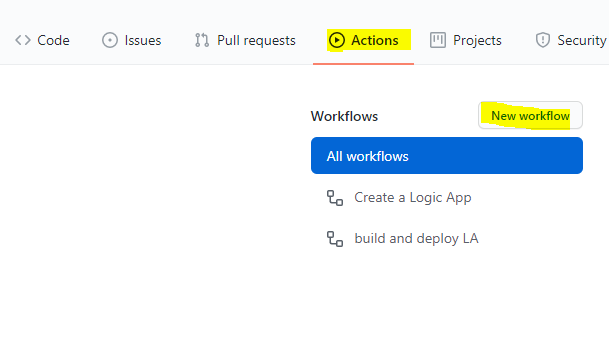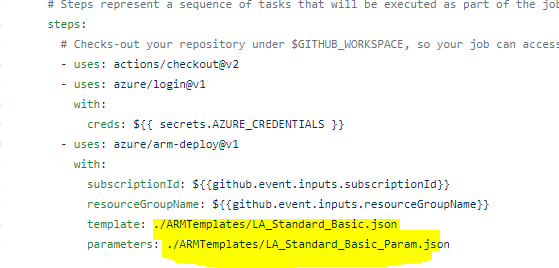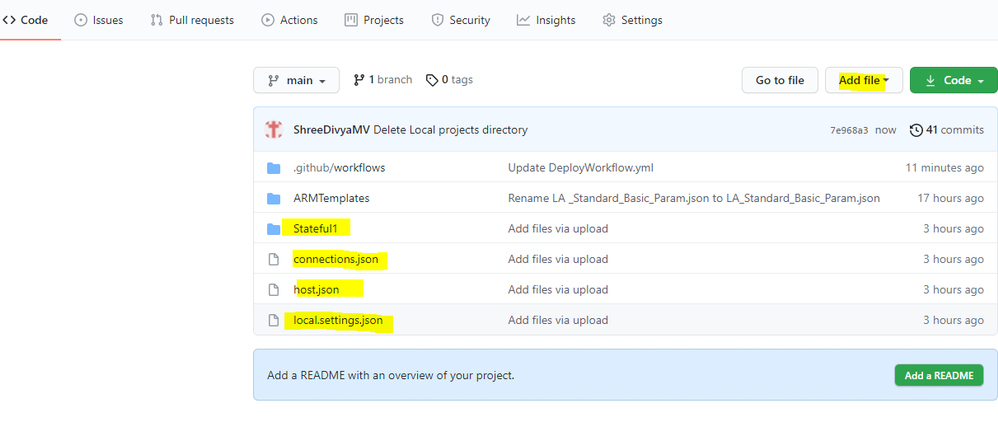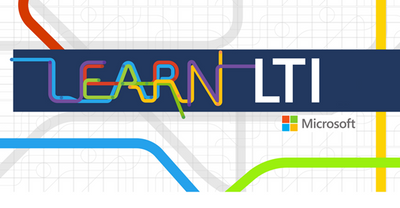
by Contributed | Jul 6, 2021 | Technology
This article is contributed. See the original author and article here.
In this article, I am providing the step-by-step instructions on provisioning a Logic App Standard resources and deploying a simple workflow to it through GitHub actions.
1. Generate deployment credentials and store it under GitHub Secrets:
To create a Service Principal for GitHub to deploy resources to Azure, In the below command, replace myApp with a unique name for your service principal and provide the resource ID of the Resource Group to which you are deploying the Logic App.
az ad sp create-for-rbac –name {myApp} –role contributor –scopes /subscriptions/{subscription-id}/resourceGroups/{MyResourceGroup} –sdk-auth
Run this command in Azure CLI and copy the complete output which looks like below.
{
“clientId”: “<GUID>”,
“clientSecret”: “<GUID>”,
“subscriptionId”: “<GUID>”,
“tenantId”: “<GUID>”,
(…)
}

In the GitHub repository, go to Settings > Secrets > New secret.
Name the secret as AZURE_CREDENTIALS and paste the output of the above CLI command.

Deploy Resource Manager templates by using GitHub Actions – Azure Resource Manager | Microsoft Docs
2. Provisioning Logic App with all the dependent resources.
1. Create ARM templates to deploy the Logic app and all the dependent resources:
Please find below the sample template and param file. This template would help to create a Storage Account, App service plan, App insight and a Logic App under the specified resource group. Please modify the parameter value as per your requirement and place these files in the GitHub repository.
https://github.com/ShreeDivyaMV/LogicAppGithub/blob/7e968a3676725ad43d5ddb2fed34f3a624919679/ARMTemplates/LA_Standard_Basic.json
https://github.com/ShreeDivyaMV/LogicAppGithub/blob/7e968a3676725ad43d5ddb2fed34f3a624919679/ARMTemplates/LA_Standard_Basic_Param.json
This example doesn’t have any API connections. If any API connections, add those to the ARM template as well. Please refer the link in the reference section for more examples.
2. Create GitHub action to deploy the Logic App:
Go to Actions tab in the repository, click on ‘new workflow’

You can refer the below YAML file for the template. You might have to modify the path and name of your ARM templates. Save this file and go back to Actions tab.
https://github.com/ShreeDivyaMV/LogicAppGithub/blob/7e968a3676725ad43d5ddb2fed34f3a624919679/.github/workflows/DeployLogicApp.yml

3. Run the GitHub action:
Select the action “create a Logic App” and provide the Subscription ID and Resource group Name and run the action.
This would create the Logic app based on the ARM template provided.

3. Deploy the workflows to the Logic App:
Copy your Logic App project folder to GitHub repository.

Go to Actions tab and create another action to deploy the workflow to the earlier provisioned Logic App.
You can refer the below YAML file for the sample.
https://github.com/ShreeDivyaMV/LgoicAppGithub/blob/44ac6e908b4818bacccab484a33075e76949e20f/.github/workflows/DeployWorkflow.yml
You can run this workflow by providing the Resource Group name and Logic App Name

References:
GitHub Repository of the above example- ShreeDivyaMV/LogicAppGithub
GitHub Repository for more examples on Logic App Standard- Azure/logicapps: Azure Logic Apps labs, samples, and tools (github.com)
More info on Logic App Standard: Overview – Single-tenant Azure Logic Apps – Azure Logic Apps | Microsoft Docs
by Scott Muniz | Jul 6, 2021 | Security, Technology
This article is contributed. See the original author and article here.
CISA has released an Industrial Controls Systems (ICS) Medical Advisory detailing multiple vulnerabilities in multiple Philips Clinical Collaboration Platform Portal (officially registered as Vue PACS) products. An attacker could exploit some of these vulnerabilities to take control of an affected system.
CISA encourages users and administrators to review the ICS medical advisory ICSMA-21-187-01 Philips Vue PACS and to apply the necessary updates or workarounds.

by Contributed | Jul 6, 2021 | Technology
This article is contributed. See the original author and article here.
Harish Bannai, Senior Azure Cloud Engineer
Jonathan Wang, Customer Engineer II
Some Azure services have adjustable quota limits. Monitoring these quota limits is critical for keeping mission-critical applications and services up and running. In this blog, we walk through the steps to use a custom script that monitors quotas for Azure services creates a support ticket leveraging the Azure Support REST API.
Step 1: Configure authentication for your app
Configure your app to use the Microsoft Identity Platform (Azure AD) as the authentication provider. You can register the application using the Azure portal or Azure CLI.
Register your app with the Azure portal
- Follow these steps to register your app in the Azure portal.
- In Azure Active Directory click App registration, click on the application you’re registering to display its properties. You will see something like this:

- Make a note of the Object ID and Directory (tenant) ID values.
Register your app using Azure CLI
To register your app using Azure CLI, run the following command to obtain the Object ID and Directory (tenant) ID values:
get-azureadapplication -objectId
Step 2: Register the resource provider (RP)
Register the Azure resource provider (RP) for the service of the quotas you want to monitor. For example, if the RP is Microsoft.Compute, you register it as follows:
Register-AzResourceProvider -ProviderNamespace Microsoft.Compute
You will get this result:
ProviderNamespace : Microsoft.Compute
RegistrationState : Registered
ResourceTypes : {availabilitySets, virtualMachines,
virtualMachines/extensions,
virtualMachineScaleSets…}
Locations : {East US, East US 2, West US, Central US…}
Step 3: Monitor your quotas programmatically
Use this script to monitor and create a support case. Pass the values for Subscription ID, Object ID, and Directory (tenant) ID obtained in the previous steps to the GetAzLimit.ps1 script to monitor quotas and auto-create the support case.

by Contributed | Jul 5, 2021 | Technology
This article is contributed. See the original author and article here.

We are a MSc student research team from Imperial College Business School London
Team members Bastian Drengemann, Mats Brandt, Bartolomeo Poggi, Lara Hartmann, and Phillip Zimmer and we are eager to understand your perspective on Microsoft Learn and the Learning Tools Interoperability (LTI) application as student or faculty. During the next weeks, we are working closely with the Microsoft Learn LTI Open Source Team to help shape the future of education tool with Microsoft Learn.
Microsoft Learn is a free, online training platform that provides interactive learning resources for Microsoft products and cutting edge technologies. The goal is to empower students and educators to learn about technology through fun, guided, hands-on content aimed at specific learning goals.
To bring Microsoft Learn’s content into the classroom, an LTI application enables you to seamlessly blend self-paced learning content from the Microsoft Learn catalog with your curriculum and Learning Management System (LMS).
Click here to find out more: https://github.com/microsoft/learn-lti
And click here to access the surveys:
For institutions: IT administrators and educators (5min)
For students (3min)
Your insights are key to understand how Learn and LTI can enter the classroom and how they offer value to a blended learning curriculum. Do you want to participate in building future learning paths? Do you want to express how you see the future of higher education?
Let us know how we can empower you as an educator or student! Click on the survey links now.












Recent Comments